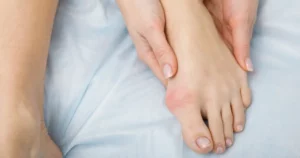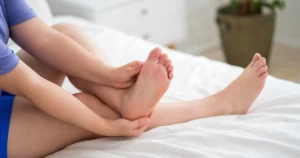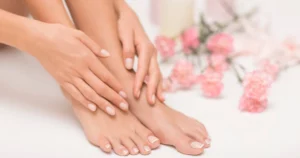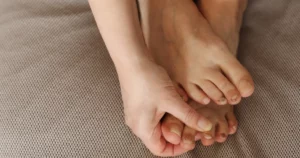
Table of Contents
Shin splints, or medial tibial stress syndrome, can sideline even the most dedicated runners. That sharp, persistent pain along the inner edge of the shinbone is more than just an annoyance; it’s your body’s way of saying something needs to change. If you’re dealing with shin splints or worried about them derailing your training, understanding the common causes and how to prevent them is key to staying on track and pain-free.
Why Do Shin Splints Happen?
- Too Much, Too Soon: One of the main culprits behind shin splints is overuse. If you’re ramping up your mileage or intensity too quickly, your tibia and the surrounding muscles, tendons, and tissues can’t keep up. The repeated impact of your feet hitting the ground creates small injuries in those tissues, leading to inflammation and pain.
- Running Form Issues: Biomechanics matter more than you might think. Overpronation, when your foot rolls inward excessively, is a common issue that puts extra stress on your lower legs. If your running form isn’t dialed in, you’re more likely to develop shin splints.
- Worn-Out or Unsupportive Shoes: Shoes that don’t provide enough cushioning or stability can leave your legs absorbing all the shock. If you’ve been wearing the same pair of running shoes for months (or years), it’s probably time for an upgrade. For runners with specific foot mechanics, orthotics or corrective shoes can be a game-changer.
- Sudden Training Changes: Switching from flat roads to hilly trails or adding speed intervals without easing into them can overload your legs. Shin splints thrive on sudden changes, so a gradual approach to new training challenges is your best bet.
- Muscle Weakness or Tightness: If your calves are weak or your Achilles tendon is tight, your lower legs are doing extra work to compensate. This imbalance can set you up for shin splints, especially if stretching and strengthening aren’t part of your routine.
- Hard Running Surfaces: Pavement and other hard surfaces don’t do your legs any favors. The constant pounding can lead to microtrauma in your tibia and surrounding tissues, increasing your risk for shin splints.
How to Prevent Shin Splints
- Ease Into Training: Patience is your friend. Avoid the temptation to pile on mileage or intensity too quickly. Follow the “10% rule,” increasing your weekly mileage or intensity by no more than 10%. Gradual progression gives your body time to adapt and recover.
- Stretching and Warming Up: Stretching isn’t optional. Dynamic stretches before a run get your muscles ready to work, while post-run static stretches keep your calves, Achilles, and other lower leg muscles flexible. A good warm-up primes your body and can reduce the likelihood of injury.
- Strength Training: Strong muscles handle stress better. Add exercises like calf raises, toe taps, and ankle-strengthening drills to your routine. These will improve your stability and resilience, helping to protect your tibia from overuse injuries. Shin splint exercises can specifically target these areas to prevent pain and enhance performance.
- Invest in the Right Shoes: The right shoes can make all the difference. Look for running shoes with proper cushioning and support tailored to your foot type. If you’re not sure what’s best for you, consider visiting a specialty running store for a gait analysis. Replace your shoes every 300 to 500 miles or as soon as they start showing wear.
- Mix Up Your Workouts: Cross-training is a great way to give your legs a break while staying active. Activities like swimming, cycling, or using an elliptical reduce the impact on your shins and help you build strength in other muscle groups. If you’re searching for shin splint home remedies, Lorain, adding cross-training can also aid recovery.
- Pick Softer Surfaces: Whenever possible, choose softer surfaces like grass, trails, or a rubberized track. Alternating between surfaces can help reduce the repetitive stress your legs endure.
- Listen to Your Body: Don’t push through pain. If your shins are sore, take a step back. Rest, ice, and adjust your training plan as needed. Pain is your body’s way of telling you something isn’t right, so don’t ignore it. Shin pain Lorain is a common issue among runners, but taking early action can make all the difference.
- Ice and Recovery Techniques: After a run, icing your shins can reduce inflammation and relieve pain. Combine this with proper recovery, including rest days, to give your body time to heal and adapt.
- Foam Rolling and Massage: Tight muscles? A foam roller or professional massage can work wonders. Regularly rolling out your calves and tibialis anterior (the muscle along your shin) helps prevent stiffness and improves blood flow. If you’re looking into shin splints treatment, Lorain, adding these techniques to your recovery plan is a smart move.
- Nutrition and Hydration: Support your body with a balanced diet rich in calcium, vitamin D, and magnesium. These nutrients promote strong bones and muscles. Staying hydrated also aids muscle recovery and overall performance.
When to Call in the Experts
If shin splint pain persists despite your best efforts, it’s time to see a professional. Disregarding the pain can lead to more serious issues, like stress fractures. A doctor or physical therapist can help pinpoint the problem and create a tailored recovery plan. Diagnostic tools like X-rays or MRIs might be needed to rule out other conditions. If you’re seeking shin splint relief in Lorain, a healthcare professional can advise you through the best options.
Takeaway
Preventing shin splints isn’t about perfection; it’s about consistency. By paying attention to your training habits, running form, and recovery routines, you can reduce your risk and stay on top of your game. Running should be something you enjoy, not something that causes pain. If you’re struggling with shin splints or need expert guidance, Integrity Foot & Ankle Associates is here to help. Our team specializes in effective solutions to get you back to doing what you love.
Book Your Consultation for Shin Splints Treatment in Lorain and Elyria, OH, today and take the first step toward lasting relief and healthier running habits with our services.




